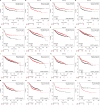Significant prognostic values of aquaporin mRNA expression in breast cancer
- PMID: 30863160
- PMCID: PMC6388951
- DOI: 10.2147/CMAR.S193396
Significant prognostic values of aquaporin mRNA expression in breast cancer
Abstract
Introduction: Aquaporins (AQPs), also called water channels, have been shown to have functions in the migration, invasion, and proliferation of human breast tumor cells. Most AQP mRNA expression levels were tested by cell lines, mouse models, and even human breast tissues. However, the mRNA expression of individual AQPs in different clinicopathologic characteristics and prognostic values according to different kinds of classifications of breast cancer patients remains unclear.
Materials and methods: In the current study, we used the Oncomine database, Breast cancer Gene-Expression Miner v4.1, Kaplan-Meier Plotter, and cBioPortal to investigate the expression distribution and prognostic values of AQPs in breast cancer patients.
Results: Our study revealed that the mRNA expression levels of AQP8, AQP9, and AQP10 were upregulated, while those of AQP3, AQP4, AQP5, and AQP7 were downregulated in breast cancer. The clinical database showed that lower mRNA levels of AQP1 were associated with a high Scarff-Bloom-Richardson grade, but AQP9 showed the opposite trend. Further survival analyses indicated that high mRNA expression levels of AQP0, AQP1, AQP2, AQP4, AQP6, AQP8, AQP10, and AQP11 were significantly associated with better relapse-free survival (RFS). Conversely, AQP3 and AQP9 were associated with worse RFS in breast cancer patients, suggesting that these two genes might be potential targets in future chemotherapy.
Discussion: These significant AQP members might be further explored as new biomarkers for breast cancer prognosis, but this needs further study.
Keywords: AQP; biomarker; breast cancer; genetic; prognostic.
Conflict of interest statement
Disclosure The authors report no conflicts of interest in this work.
Figures





References
-
- Nicolini A, Ferrari P, Duffy MJ. Prognostic and predictive biomarkers in breast cancer: past, present and future. Semin Cancer Biol. 2018;52(Pt 1):56–73. - PubMed
-
- Hernandez-Vargas H, Ouzounova M, Le Calvez-Kelm F, et al. Methylome analysis reveals JAK-STAT pathway deregulation in putative breast cancer stem cells. Epigenetics. 2011;6(4):428–439. - PubMed
LinkOut - more resources
Full Text Sources

